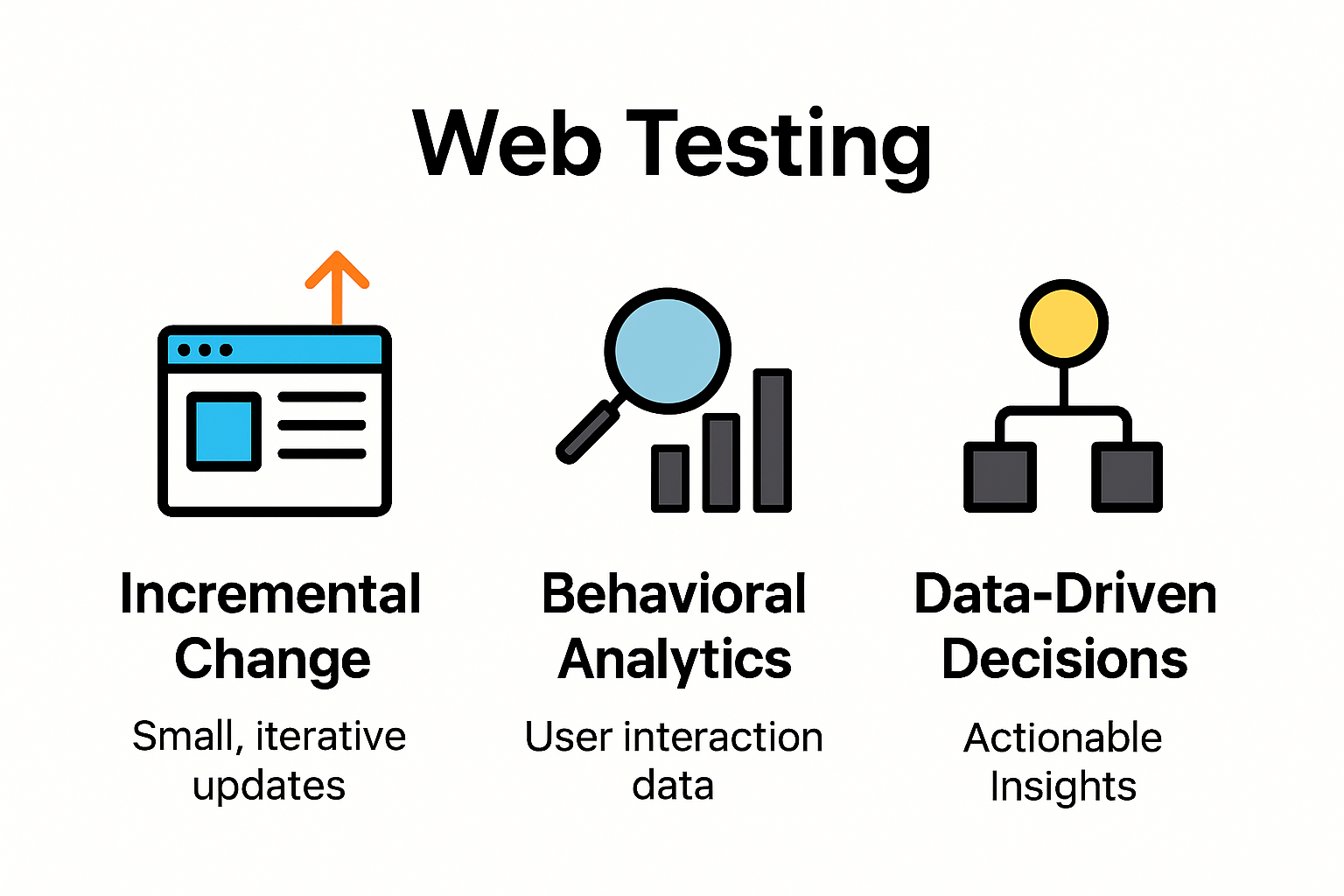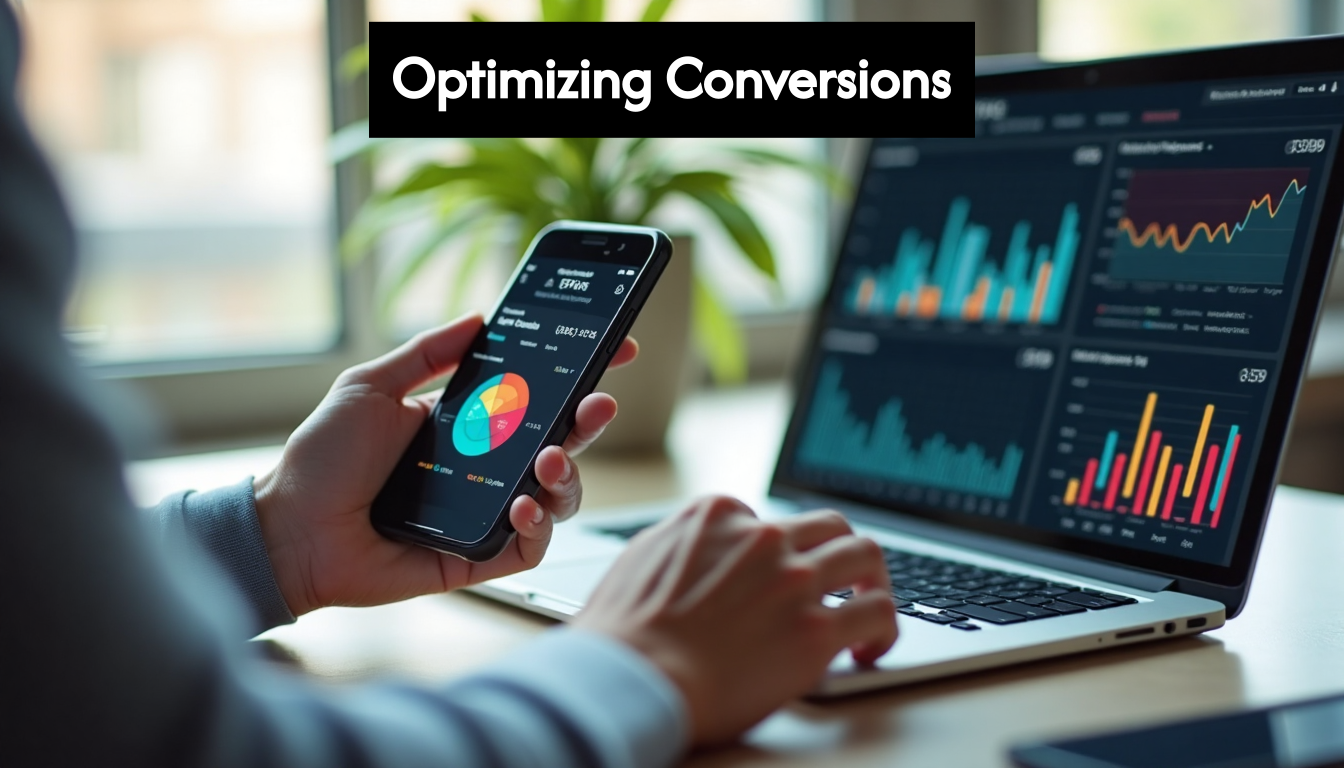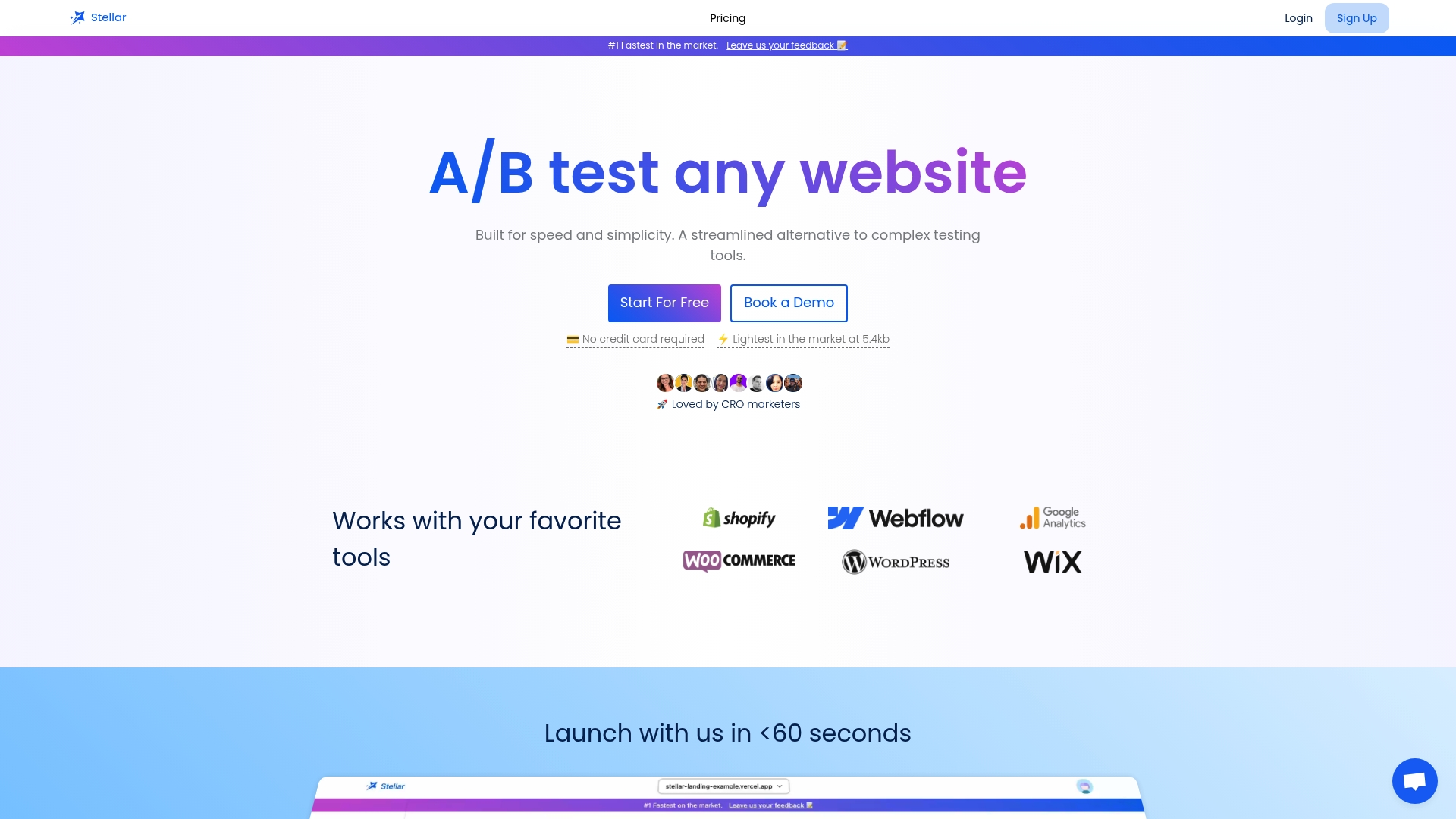
Web Based Testing Strategies for CRO and Growth Teams 2025

Web based testing is reshaping how digital teams boost results across websites and apps. Here is the surprise. Over 62 percent of website visits in 2025 come from mobile devices but most testing strategies still focus on desktop experiences. It turns out that scaling experiments for real growth is less about massive redesigns and more about precise changes, smart analytics, and continuous learning. Curious? The methods that win in 2025 are the ones most companies are still overlooking.
Table of Contents
- Core Principles Of Web Based Testing
- Types Of Web Based Tests For Optimizing Conversions
- Best Practices For Scaling Web Based Testing
- Measuring Success And ROI Of Web Based Testing
Quick Summary
| Takeaway | Explanation |
|---|---|
| Incremental Testing is Key | Focus on making small, targeted changes to determine the exact impact on user behavior and conversion rates, rather than implementing extensive redesigns. |
| Emphasize Data-Driven Insights | Rely on behavioral analytics tools like heatmaps and session recordings to gain a deeper understanding of user interactions and optimize accordingly. |
| Adopt Continuous Testing Frameworks | Create a systematic environment for ongoing testing to consistently capture and implement insights, ensuring iterative improvements over time. |
| Leverage Advanced Technologies | Utilize AI and machine learning to predict user behavior and streamline testing processes, while ensuring minimal impact on website performance. |
| Measure Comprehensive ROI | Go beyond basic conversion rates by calculating total returns, considering direct cost savings, revenue generation, and risk mitigation for a thorough understanding of optimization value. |
Core Principles of Web Based Testing
Web based testing represents a sophisticated approach to understanding and improving digital experiences through systematic experimentation. Unlike traditional evaluation methods, this strategy focuses on empirical data collection and strategic optimization across digital platforms.

Incremental Change and Precise Measurement
Successful web based testing hinges on a methodical approach of making small, targeted modifications. Conversion experts recommend testing one specific element at a time rather than implementing wholesale page redesigns. This granular method allows teams to pinpoint exactly which changes drive user behavior and impact conversion rates.
By isolating individual components like headlines, call-to-action buttons, or image placements, growth teams can generate precise insights. For instance, changing a single word in a headline might reveal significant user engagement shifts. This principle of incremental testing minimizes risk and provides clear, actionable data about what resonates with your audience.
Behavioral Understanding Through Advanced Analytics
Comprehensive web based testing goes beyond surface level metrics. User behavior analysis involves deploying sophisticated tools like session recordings, heatmaps, and interactive feedback mechanisms. These technologies offer unprecedented visibility into how users interact with digital interfaces.
Heatmaps reveal where users click, scroll, and spend time on a page. Session recordings provide a granular replay of individual user journeys, exposing potential friction points or confusing navigation elements. Feedback forms capture qualitative insights that raw numerical data might miss. By combining these approaches, teams transform raw data into strategic understanding.
Data Driven Decision Making
The core philosophy of web based testing is eliminating guesswork through rigorous experimentation. Conversion optimization frameworks emphasize creating hypotheses rooted in observable user behavior, then systematically validating those hypotheses through controlled experiments.
This approach requires a disciplined methodology:
- Hypothesis Formation: Develop specific, measurable predictions about user behavior
- Experiment Design: Create controlled tests that can definitively prove or disprove the hypothesis
- Statistical Validation: Use robust statistical methods to ensure results are not random
Moreover, our lightweight testing solution enables teams to conduct these experiments without compromising website performance. By maintaining a minimal script size and focusing on core web vitals, modern testing platforms allow continuous optimization without sacrificing user experience.
Successful web based testing is not about massive transformations but strategic, data informed refinements that compound into significant performance improvements over time.
Types of Web Based Tests for Optimizing Conversions
Web based testing offers growth teams a strategic arsenal of techniques to decode and enhance digital user experiences. Each testing method provides unique insights into user behavior, enabling precise optimization of conversion pathways.
Comparative Split Testing
A/B testing remains the cornerstone of web based testing strategies. Research reveals that systematic comparison of page variations allows teams to scientifically determine which design elements most effectively drive conversions. This method involves creating two versions of a webpage with minimal differences and tracking user interactions to identify the most compelling variant.
Typical elements tested through A/B methodologies include headlines, call-to-action button colors, image placements, form lengths, and copy variations. By isolating single variables, teams can generate statistically significant insights about user preferences. Our comprehensive split testing guide offers deeper strategies for maximizing these experiments.
Personalization and Segmentation Testing
Advanced web based testing now emphasizes personalized user experiences. Conversion optimization experts highlight the growing importance of tailoring digital interactions based on individual user characteristics. This approach involves creating targeted landing pages, customized call-to-action buttons, and dynamically adjusted product recommendations.
Personalization testing goes beyond generic user experience by segmenting audiences based on behaviors like:
- Geographic Location: Adjusting content and offers
- Previous Purchase History: Recommending relevant products
- User Device Type: Optimizing mobile and desktop experiences
- Browsing Behavior: Personalizing content based on interaction patterns
Mobile Experience Optimization
With mobile traffic dominating digital interactions, web based testing must prioritize mobile experience optimization. Global traffic analysis indicates over 62% of website visits in 2025 originate from mobile devices, underscoring the critical need for mobile-focused testing strategies.
Mobile testing encompasses multiple dimensions:
- Responsive Design Validation: Ensuring seamless display across device sizes
- Touch Interface Usability: Testing button sizes, navigation ease
- Load Time Performance: Measuring and minimizing mobile page load speeds
- Mobile Checkout Processes: Streamlining conversion funnels for smaller screens

By implementing these diverse web based testing approaches, growth teams can create increasingly sophisticated, user centric digital experiences that dynamically adapt to evolving user expectations.
Best Practices for Scaling Web Based Testing
Scaling web based testing requires a strategic approach that balances technological sophistication with systematic methodology. Growth teams must develop robust frameworks that enable continuous optimization while maintaining performance and user experience.
Establishing a Continuous Testing Framework
Conversion optimization experts emphasize the importance of treating website optimization as an ongoing experiment. Continuous testing goes beyond occasional modifications, creating a dynamic environment where incremental improvements compound over time. This approach requires building a structured process that systematically captures, analyzes, and implements insights from each testing iteration.
Key components of a continuous testing framework include:
- Regular Testing Cadence: Scheduling consistent experiment cycles
- Comprehensive Tracking: Documenting all test results and learnings
- Cross Functional Collaboration: Ensuring insights are shared across teams
Leveraging Advanced Technologies
Emerging technologies are transforming web based testing capabilities. Artificial intelligence and machine learning algorithms now enable predictive analysis that can anticipate user behavior and suggest optimization strategies. Cloud based platforms provide scalable infrastructure that supports complex, multi variant testing across different device types and user segments.
Performance focused testing tools are critical for maintaining website speed while conducting extensive experiments. These lightweight solutions minimize script overhead, ensuring that testing processes do not compromise user experience or site performance. By selecting tools with minimal performance impact, teams can conduct more frequent and comprehensive tests.
Strategic Element Prioritization
Systematic testing approaches recommend prioritizing key website elements that have the most significant potential impact on conversion rates. Rather than attempting to test everything simultaneously, successful teams focus on high leverage components such as:
- Value Propositions: Testing headline messaging
- Call to Action Designs: Experimenting with button styles and copy
- User Navigation Flows: Analyzing and optimizing conversion paths
- Form Optimization: Streamlining user input processes
Successful scaling of web based testing requires a holistic approach that combines technological innovation, systematic methodology, and a commitment to continuous learning. By implementing these best practices, growth teams can transform their digital experiences through data driven optimization.
Measuring Success and ROI of Web Based Testing
Measuring the success and return on investment of web based testing requires a comprehensive approach that goes beyond traditional metrics. Growth teams must develop sophisticated frameworks that capture both quantitative and qualitative insights to demonstrate the true value of their optimization efforts.
Key Performance Indicators for Testing Success
Test automation research reveals that organizations are increasingly sophisticated in their approach to measuring testing outcomes. The most effective measurement strategies extend beyond simple conversion rates, incorporating a holistic view of digital performance.
Critical performance indicators include:
- Conversion Rate Impact: Direct measurement of testing variations
- Revenue per Visitor: Tracking financial outcomes of optimization
- User Experience Metrics: Analyzing engagement and satisfaction
- Cost of Acquisition: Evaluating efficiency of conversion improvements
Advanced Measurement Technologies
AI driven testing solutions are transforming how teams measure testing success. By 2025, these technologies are expected to cover more than 60% of enterprise test cases, providing unprecedented depth of insight. Our comprehensive testing guide highlights the importance of integrating advanced analytical approaches.
Key technological advancements in measurement include:
- Predictive Analytics: Forecasting potential outcomes
- Machine Learning Algorithms: Identifying complex performance patterns
- Real Time Performance Tracking: Monitoring continuous optimization impacts
- Cross Platform Measurement: Analyzing results across multiple user interfaces
Calculating Comprehensive ROI
Performance testing experts indicate that test automation tools can generate returns as high as 400% within the first year. Calculating true ROI requires a multifaceted approach that considers both direct and indirect benefits of web based testing.
Components of comprehensive ROI calculation:
- Direct Cost Savings: Reduced manual testing expenses
- Opportunity Costs: Revenue generated through optimization
- Risk Mitigation: Preventing potential conversion losses
- Competitive Advantage: Improved user experience and market responsiveness
Successful ROI measurement transforms web based testing from a tactical activity to a strategic business driver. By adopting comprehensive measurement approaches, growth teams can demonstrate the tangible value of their optimization efforts and secure continued investment in continuous improvement initiatives.
Frequently Asked Questions
What is web based testing in the context of CRO?
Web based testing is a systematic approach to optimizing digital experiences through controlled experiments, focusing on small changes that impact user behavior and conversion rates rather than large redesigns.
Why is incremental testing important for growth teams?
Incremental testing allows growth teams to isolate specific changes, making it easier to measure their effects on user engagement and conversion rates without the risk associated with broader redesigns.
How can advanced analytics improve web based testing?
Advanced analytics tools, like heatmaps and session recordings, provide deep insights into user behavior, revealing patterns and friction points that can inform targeted optimizations for enhanced conversion rates.
What are some best practices for scaling web based testing?
Best practices include establishing a continuous testing framework, leveraging advanced technologies like AI, and prioritizing key website elements that significantly impact conversion rates.
Ready to Accelerate Your CRO Experiments Without Slowing Down Your Site?
You just learned that incremental testing, real-time analytics, and speed-focused tools are the cornerstone strategies for 2025. The article revealed a common frustration: most A/B testing tools either bloat your site, disrupt user experience, or require too much technical setup. If you are tired of clunky platforms and slow results, it is time for a solution that finally gets out of your way.

Discover how Stellar transforms web-based testing into something effortless and powerful. Experience a lightweight platform (just 5.4KB) with no-code editing, instant analytics, and advanced goal tracking. Start now for free and watch your conversion rates climb—all without sacrificing site speed or needing an IT team. See how easy A/B testing can be.
Recommended Articles
Published: 6/18/2025